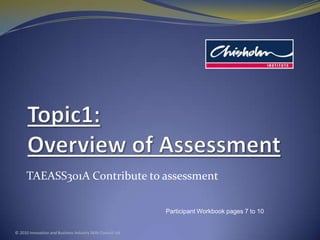Taeass301 a topic1
- 1. Topic1: Overview of AssessmentTAEASS301A Contribute to assessment? 2010 Innovation and Business Industry Skills Council LtdParticipant Workbook pages 7 to 10
- 2. At the end of this session, you should know how to:describe what is meant by competency-based assessment in VETidentify your role in the assessment process.? 2010 Innovation and Business Industry Skills Council Ltd
- 3. Assessment in VET? 2010 Innovation and Business Industry Skills Council LtdParticipant Workbook page 7
- 4. Competency-based assessmentPeople measured against a standard, not against each other.Compare with norm-referenced assessment ©C people ranked against each other.? 2010 Innovation and Business Industry Skills Council LtdParticipant Workbook page 8
- 5. Evidence for assessmentInformation gathered to support a judgement of competency against the relevant specificationsCould include:samples of a candidateĪ»s workchecklists completed after observing a candidaterecord of an interview with a candidatereport from a supervisor in the workplaceanswers to questions you asked the candidateworkplace documents completed by the candidate.? 2010 Innovation and Business Industry Skills Council LtdParticipant Workbook page 9
- 6. Your assessment? 2010 Innovation and Business Industry Skills Council Ltd
- 7. Contributing to assessment? 2010 Innovation and Business Industry Skills Council LtdParticipant Workbook page 9
- 8. The next stepYou should now:start planning for your role in gathering evidence for assessment? 2010 Innovation and Business Industry Skills Council Ltd







